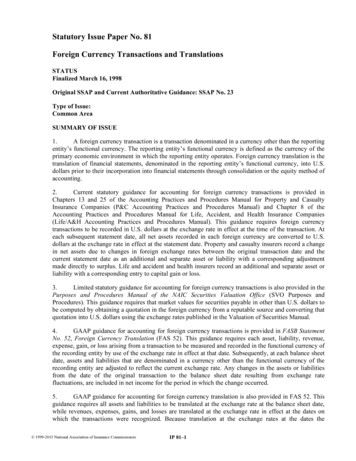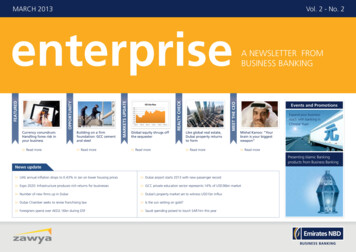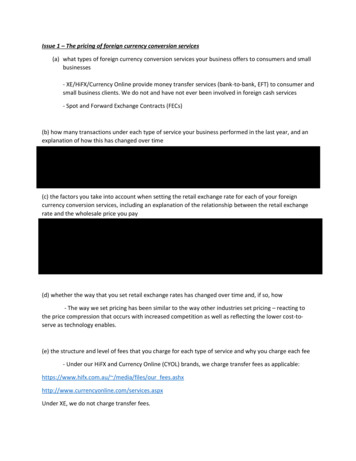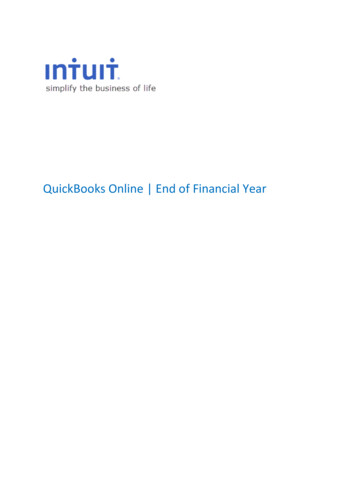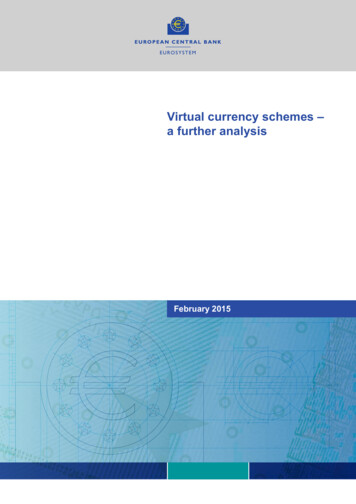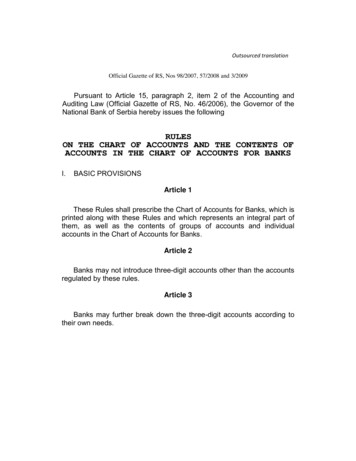
Transcription
www.pwc.comForeign currencyPartially updated July 2019
Foreign currency214This publication has been prepared for general informational purposes, and does not constitute professional advice on facts andcircumstances specific to any person or entity. You should not act upon the information contained in this publication withoutobtaining specific professional advice. No representation or warranty (express or implied) is given as to the accuracy orcompleteness of the information contained in this publication. The information contained in this publication was not intended orwritten to be used, and cannot be used, for purposes of avoiding penalties or sanctions imposed by any government or otherregulatory body. PricewaterhouseCoopers LLP, its members, employees, and agents shall not be responsible for any losssustained by any person or entity that relies on the information contained in this publication. Certain aspects of this publicationmay be superseded as new guidance or interpretations emerge. Financial statement preparers and other users of thispublication are therefore cautioned to stay abreast of and carefully evaluate subsequent authoritative and interpretativeguidance.The FASB Accounting Standards Codification material is copyrighted by the Financial AccountingFoundation, 401 Merritt 7, Norwalk, CT 06856, and is reproduced with permission.
PwC guide libraryOther titles in the PwC accounting and financial reporting guide series: Bankruptcies and liquidations Business combinations and noncontrolling interests, global edition Consolidation and equity method of accounting Derivatives and hedging Fair value measurements, global edition Financial statement presentation Financing transactions IFRS and US GAAP: similarities and differences Income taxes Leases Loans and investments Property, plant, equipment and other assets Reinsurance—short duration contracts Revenue from contracts with customers, global edition Stock-based compensation Transfers and servicing of financial assets Utilities and power companies
AcknowledgmentsThe Foreign currency guide represents the efforts and ideas of many individuals within PwC. Thefollowing PwC people contributed to the contents or served as technical reviewers of this publication:Core teamJohn BishopNora JoyceJohn F. Horan IIIKen MillerMike YenchekContributorsJohn AlthoffMaria ConstantinouDominick KerrMaria MirettiPaul MoranJohn TorielloSal VolpeJeff WadsworthValerie WiemanSpecial thanksSpecial thanks to all the other PwC professionals who contributed to the overall quality of this guide,including the final editing and production of the document.
About the Foreign currencyguidePwC is pleased to offer our Foreign currency guide. This guide was issued in November 2014. Sincethen, certain sections have been updated to reflect new guidance or interpretations. See Appendix D,Summary of significant changes, for more information.The accounting guidance on foreign currency matters was written more than 30 years ago; yet thistopic remains particularly relevant in today’s global economy. Since the accounting literature wasoriginally issued, many companies have changed their operating structures, expanded internationally,and often transact business in multiple global currencies. Although accounting for foreign currencymatters has always been a challenging area, globalization has led to increased complexities withrespect to the application of this guidance.This guide begins with a summary of the overall framework for accounting for foreign currencymatters. The ensuing chapters further discuss each step in the framework, including identifyingforeign entities, determining functional currencies, accounting for foreign currency transactions, andtranslating financial statements of foreign entities. This guide also discusses accounting implicationsrelated to highly inflationary economies, intercompany transactions denominated in foreigncurrencies, and acquisitions and dispositions of foreign operations.Each chapter highlights key aspects of the guidance and includes specific questions and examples toillustrate its application, particularly in today’s modern economy. Relevant references to and excerptsfrom the FASB’s Accounting Standards Codification are interspersed throughout the guide.Guidance on financial statement presentation and disclosure, foreign currency-related hedgingactivities, and income tax accounting can be found in other PwC guides.References to US GAAPDefinitions, full paragraphs, and excerpts from the Financial Accounting Standards Board’sAccounting Standards Codification are clearly designated, either within quotes in the regular text orenclosed within a shaded box. In some instances, guidance was cited with minor editorial modificationto flow in the context of the PwC Guide. The remaining text is PwC’s original content.References to other chapters and sections in this guideWhen relevant, the discussion includes general and specific references to other chapters of the guidethat provide additional information. References to another chapter or particular section within achapter are indicated by the abbreviation “FX” followed by the specific section number (e.g., FX 2.3.2refers to section 2.3.2 in chapter 2 of this guide).References to other PwC guidanceThis guide focuses on the accounting and financial reporting considerations for foreign currencymatters. It supplements information provided by the authoritative accounting literature and otherPwC guidance. This guide provides general and specific references to chapters in other PwC guides toassist users in finding other relevant information. References to other guides are indicated by the
Prefaceapplicable guide abbreviation followed by the specific section number. The other PwC guides referredto in this guide, including their abbreviations, are: Business combinations and noncontrolling interests, global edition (BCG) Derivatives and hedging (DH) Financial statement presentation (FSP) Income taxes (TX) Leases (LG) Loans and investments (LI)PwC guides may be obtained through CFOdirect (www.cfodirect.com), PwC’s comprehensive onlineresource for financial executives, a subscription to Inform (www.pwcinform.com), PwC’s onlineaccounting and financial reporting reference tool, or by contacting a PwC representative.Guidance dateThis guide considers existing guidance as of November 30, 2014. Certain sections have been updatedto keep pace with significant developments. Users should ensure they are using the most recent editionavailable on CFOdirect (www.cfodirect.com) or Inform (www.pwcinform.com).Other informationThe appendices to this guide include guidance on professional literature, a listing of technicalreferences and abbreviations, definitions of key terms, and a summary of significant changes.*****This guide has been prepared to support you in applying the foreign currency accounting guidance. Itshould be used in combination with a thorough analysis of the relevant facts and circumstances,review of the authoritative accounting literature, and appropriate professional and technical advice.Paul KeppleUS Chief Accountant
Table of contents1. Framework for accounting for foreign currency1.1.Chapter overview . 1-21.2. Limitations of ASC 830 . 1-31.3. Framework for the application of ASC 830 . 1-42. Determining whether an entity is a distinct and separable operation2.1. Chapter overview . 2-22.2. Definition of a foreign entity . 2-22.3. Identifying distinct and separable operations . 2-22.4. Application examples . 2-43. Determining functional currency3.1. Chapter overview . 3-23.2. Determining functional currency . 3-23.3. Change in functional currency . 3-114. Foreign currency transactions – updated June 20194.1. Chapter overview . 4-24.2. Foreign currency transactions. 4-24.3. Initial measurement of foreign currency transactions . 4-34.4. Subsequent measurement of foreign currency transactions . 4-34.5. Exchange rates .4-74.6. Property, plant and equipment . 4-84.7. Foreign currency denominated leases . 4-94.8. Investments in debt and equity securities denominated in a foreign currency . 4-114.9. Deferred revenue .4-184.10. Debt . 4-194.11. Asset retirement obligations . 4-194.12. Equity transactions . 4-204.13. Share based payments . 4-21
Table of contents5. Translating the financial statements of a foreign entity5.1. Chapter overview . 5-25.2. Translation procedures . 5-25.3. Translation when a foreign entity maintains its books and recordsin its functional currency . 5-35.4. Translation when a foreign entity maintains its books andrecords in a currency other than its functional currency . 5-75.5. Exchange rates . 5-155.6. Cumulative translation adjustment . 5-196. Foreign entities in highly inflationary economies – updated June 20196.1. Chapter overview . 6-26.2. Determining whether an economy is highly inflationary . 6-26.3. Accounting for a foreign entity in a highly inflationary economy . 6-36.4. Accounting once an economy is no longer highly inflationary . 6-137. Intercompany transactions7.1.Chapter overview .7-27.2. Intercompany balances.7-27.3. Elimination of intercompany profits .7-47.4. Intercompany dividends .7-67.5. Accounting for long term intercompany loans and advances . 7-77.6. Exchange rate applicable to intercompany transactions . 7-128. Acquisitions and dispositions involving a foreign operation – updated June 20198.1. Chapter overview . 8-28.2. Acquisition of a foreign operation. 8-28.3. Disposition of a foreign operation . 8-48.4. Impairment calculations that should consider accumulated CTA .8-12AppendicesAppendix A: Professional literature. A-1Appendix B: Technical references and abbreviations . B-1Appendix C: Key terms .C-1Appendix D: Summary of significant changes . D-1
Chapter 1:Framework for accountingfor foreign currency1
Framework for accounting for foreign currency1.1Chapter overviewWhen a reporting entity conducts transactions in more than one currency, preparing financialstatements in a single currency requires that changes in the relationship between different unitsof currency be recognized and measured. ASC 830, Foreign Currency Matters, uses the followingtwo distinct processes to express all of a reporting entity’s transactions in a single reportingcurrency. Foreign currency measurement–This is the process by which an entity expresses transactionswhose terms are denominated in a foreign currency in its functional currency. Changes infunctional currency amounts that result from the measurement process are called transactiongains or losses; transaction gains and losses are included in net income. Foreign currency translation–This is the process of expressing a foreign entity’s functionalcurrency financial statements in the reporting currency. Changes in reporting currencyamounts that result from the translation process are called translation adjustments;translation adjustments are included in the cumulative translation adjustment (CTA) account,which is a component of other comprehensive income:The application of the measurement and translation processes starts with an understanding of thefollowing concepts and definitions. Not all terms listed below are defined in the FASB’sAccounting Standards Codification.Figure 1-1 defines common terms used in ASC 830.Figure 1-1Basic foreign currency termsTermDefinitionReporting currencyThe currency in which a reporting entity prepares its financialstatementsForeign currencyAny currency other than the functional currency of the referenceddistinct and separable operationForeign entityA distinct and separable operation whose financial statements areprepared in a currency other than the reporting currency, and that isconsolidated, combined, or accounted for on the equity method. Areporting entity must identify its foreign entities to determine whichfinancial statements have to be translated. Distinct and separableoperations whose financial statements are prepared in the reportingcurrency are domestic entities which, by definition, do not need to betranslated.Distinct and separableoperationAn operation that can be clearly distinguished, operationally and forfinancial reporting purposes, from the rest of the reporting entity forwhich a meaningful set of financial statements are routinely preparedFunctional currencyThe currency of the primary economic environment in which a distinctand separable operation operates1-2
Framework for accounting for foreign currencyThis chapter of PwC’s Foreign currency guide provides an overall framework for accounting forforeign currency matters.1.2Limitations of ASC 830The guidance codified in ASC 830 has not changed significantly since its issuance in 1981. At thattime, the US and the US dollar dominated the global business environment. The internationaloperations of US reporting entities were typically extensions of large, established US operatingcompanies, and “foreign entities” were generally much smaller than the operations in the US Inaddition, almost all intercompany transactions flowed from the US to foreign operations. Becauseof this historical bias, the guidance in ASC 830 assumes that the reporting entity is located in theUS, uses the US dollar as its reporting currency, is an operating company with a functionalcurrency of the US dollar, and provides support to its foreign operations. Figure 1-2 illustrates theoperating structure assumed by the guidance in ASC 830.Figure 1-2Operating structure assumed by ASC 830In today’s modern economy, many US reporting entities are holding companies with nosignificant operations; they hold operating companies in the United States and around the world.The US operating company may not be the reporting entity’s largest operating company, and inmany cases the foreign operations provide support to the US operations. In addition, transactionsin the modern economy may be denominated in a number of global currencies, and an operation’sphysical location no longer determines its functional currency. For example, a reporting entitydomiciled in Canada may conduct most of its business in the US dollar, while a reporting entitydomiciled in the US may conduct most of its business in the Canadian dollar. As a result,determining functional currencies today is much more difficult than when ASC 830 was issued.Figure 1-3 shows an example of a modern day operating structure.1-3
Framework for accounting for foreign currencyFigure 1-3Modern day operating structure (2014)While accounting for foreign currency matters has always been a challenging area that oftenrequires significant judgment, the lack of clarity surrounding how to apply ASC 830 to a modernoperating structure and how the definitions and units of account within ASC 830 interact withsubsequently issued accounting standards has increased the challenges. To assist inunderstanding how ASC 830 should be applied today, we have developed additional terms (suchas domestic entity) that are not used in ASC 830. In certain places we have included explanationsto clarify the ASC references.1.3Framework for the application of ASC 830Depending on the scope and structure of its consolidated operations, a reporting entity may havetransactions denominated in a foreign currency (which need to be measured in a functionalcurrency), or it may have foreign entities (which need to be translated into the reportingcurrency). To prepare consolidated financial statements, all amounts denominated in foreigncurrencies should be either measured or translated (or both) into the reporting currency.Figure 1-4 summarizes the key steps in the application of ASC 830. An understanding of thevarious defined terms is critical to navigating the ASC 830 framework.Figure 1-4Framework for the application of ASC 8301-4
Framework for accounting for foreign currencyStep 1: Identify the reporting entity’s reporting currencyASC 830-10-20 provides the definitions of reporting entity and reporting currency.Definitions from ASC 830-10-20Reporting Currency: The currency in which a reporting entity prepares its financial statements.Reporting Entity: An entity or group whose financial statements are being referred to. Thosefinancial statements reflect any of the following:a.The financial statements of one or more foreign operations by combination, consolidation, orequity accountingb. Foreign currency transactions.1-5
Framework for accounting for foreign currencyThe reporting currency is often the currency of the country in which the reporting entity islocated, but it does not have to be. A private reporting entity may select any currency for itsreporting currency. For example, a foreign private issuer may choose to prepare financialstatements in US dollars for purposes of reporting to investors in the United States. In that case,its reporting currency is the US dollar. Rule 3-20 of Regulation S-X requires US incorporatedregistrants to present their financial statements in U.S dollars, with limited exceptions.Step 2: Identify the reporting entity’s foreign entitiesA foreign entity is a distinct and separable operation that is combined, consolidated, or accountedfor using the equity method of accounting and has a functional currency other than the reportingentity’s reporting currency.FX 2 discusses identifying a reporting entity’s distinct and separable operations.Step 3: Determine the functional currency of each distinct and separable operationThe functional currency of a distinct and separable operation is a question of fact. An operationdoes not choose its functional currency. ASC 830-10-20 provides a definition of functionalcurrency.Definition from ASC 830-10-20Functional Currency: An entity’s functional currency is the currency of the primary economicenvironment in which the entity operates; normally, that is the currency of the environment inwhich an entity primarily generates and expends cash.The determination of a distinct and separable operation’s functional currency may bestraightforward. For example, the functional currency of a distinct and separable operationintegrated within a particular country with self-contained operations would likely be the currencyof that country. Similarly, the US dollar is typically the functional currency of an operation that isa direct and integral component or extension of a US parent’s operations. However, thedetermination of the functional currency of a distinct and separable operation is often complexand may require significant judgment. It is not common for the functional currency of a distinctand separable operation to change, unless there are significant changes in external economic factsand circumstances. See FX 3 for further information on factors to consider in determining thefunctional currency.In addition, ASC 830 contains specific provisions for determining the functional currency of aforeign entity operating in a country with a highly inflationary economy. See FX 6 for furtherinformation on the applicable considerations if a foreign entity operates in a highly inflationaryeconomy.Step 4: Measure foreign currency transactionsWhen an operation has transactions denominated in a currency other than its functionalcurrency, they must be measured in the functional currency. Changes in the expected functionalcurrency cash flows caused by changes in exchange rates are included in net income in the period.ASC 830-10-20 defines foreign currency transactions.1-6
Framework for accounting for foreign currencyDefinition from ASC 830-10-20Foreign Currency Transactions: Transactions whose terms are denominated in a currency otherthan the entity’s functional currency. Foreign currency transactions arise when a reporting entity[or distinct and separable operation] does any of the following:a.Buys or sells on credit goods or services whose prices are denominated in foreign currencyb. Borrows or lends funds and the amounts payable or receivable are denominated in foreigncurrencyc.Is a party to an unperformed forward exchange contractd. For other reasons, acquires or disposes of assets, or incurs or settles liabilities denominated inforeign currency.Foreign currency transactions are initially recorded in an operation’s functional currency.Subsequent measurement of foreign currency transactions will depend on whether thetransaction gives rise to an account balance that is monetary or nonmonetary. Monetary assets and liabilitiesMonetary assets and liabilities, such as cash, accounts receivable, accounts payable, and longterm debt, create foreign currency exchange rate risk as they represent amounts that will besettled with counterparties in a currency other than an operation’s functional currency.Monetary assets and liabilities are measured at the end of each reporting period based on thethen current exchange rates. This measurement gives rise to foreign currency gains andlosses, which are recorded in current period net income. Nonmonetary assets and liabilitiesNonmonetary assets and liabilities, such as inventory and property, plant, and equipment, donot require future settlement or adjustment. Nonmonetary assets and liabilities are initiallymeasured using historical exchange rates. All aspects of the ongoing accounting for theseitems (e.g., depreciation, impairment, lower of cost or market) should be measured in termsof the operation’s functional currency.See FX 4 for further information on the measurement of foreign currency transactions.Step 5: Translate financial statements of foreign entitiesForeign currency translation is the process of expressing a foreign entity’s financial statements inthe reporting currency of the reporting entity. The purpose of translation is to express a foreignentity’s functional currency financial statements in terms of the reporting currency. Thus, when areporting entity’s financial statements include the results of foreign entities, the reporting entitymust translate the foreign entity’s financial statements before they can be consolidated.The financial statements of a foreign entity should be translated into the functional currency of itsimmediate parent company based on the nature of the account as follows:1-7
Framework for accounting for foreign currency The period-end spot rate for assets and liabilities The weighted average exchange rate for income statement accounts Historical exchange rates for equity accounts (except for the change in retained earningsduring the year, which is the result of the income statement translation process)Once the reporting entity has translated its foreign entity financial statements, it should recordthese amounts in its consolidated financial statements. We refer to the “immediate” parent, asASC 830 should be applied to each individual layer of a consolidation, beginning with the lowestlevel of the consolidated reporting entity’s organizational structure. Gains and losses (and theassociated tax effect) from the effect of exchange rate differences in translation are recorded inthe CTA account. CTA is a separate component of accumulated other comprehensive income(OCI) in shareholders’ equity.See FX 5 for further information on foreign currency financial statement translation.Question 1-1 addresses how to translate financial statements when a foreign entity does notmaintain its financial statements in its functional currency.Question 1-1How should the financial statements of a foreign entity that does not maintain its financialstatements in its functional currency be translated?PwC responseA foreign entity may choose (or be required by law) to maintain its books and records in a localcurrency that is not its functional currency. In accordance with ASC 830, before the local currencyfinancial statements (prepared in accordance with US GAAP) are translated to the reportingentity’s reporting currency, they should be “remeasured” (so called because they were alreadymeasured in the local currency, which may have created transaction gains and losses) into theforeign entity’s functional currency. This remeasurement should provide results comparable tothose that would have occurred had the entity used its functional currency to maintain its records.Step 6: Release the cumulative translation adjustment into net income, asapplicableASC 830-30-40-1 requires CTA to be reclassified from equity to net income “upon sale or uponcomplete or substantially complete liquidation of an investment in a foreign entity.” Therefore,when disposing of any foreign operation, it is important to understand if that foreign operationconstitutes a foreign entity, or is a component of a foreign entity. Acquiring control of a foreignoperation in a step acquisition may also require that CTA be released to net income.See FX 8 for further information on acquisitions and dispositions of foreign operations.1-8
Chapter 2:Determining whether anentity is a distinct andseparable operation1
Determining whether an entity is a distinct and separable operation2.1Chapter overviewA critical step in the application of ASC 830 is the identification of a reporting entity’s foreign entities,which by definition must be a distinct and separable operation.Whether an operation is a distinct and separable foreign entity will depend on the manner in whichthe operations are structured. If an operation does not qualify as distinct and separable, it should beconsidered an extension of its most immediate parent. A reporting entity should periodically revisit itsassessment to determine whether facts and circumstances have changed in such a way as to impactwhat are considered distinct and separable operations.This chapter discusses how to identify distinct and separable operations and how
ASC 830, Foreign Currency Matters, uses the following two distinct processes to express all of a reporting entity's transactions in a single reporting currency. Foreign currency measurement-This is the process by which an entity expresses transactions whose terms are denominated in a foreign currency in its functional currency. Changes in
